 |
Here are the various SLR cameras in my collection. SLR stands for single lens reflex, cameras that show the subject through the camera lens by means of a mirror and pentaprism or waist-level viewfinder. I tend not to collect these, at least not systematically as I prefer the range and viewfinders of earlier days (and one has to draw a line somewhere!), but I do have several scattered on this site, including several Kodak Retina Reflex, Agfa Ambiflex and some Ihagee Exa/Exaktas. Over the course of the last few years my SLR collection has expanded enough that a dedicated page is warranted, and includes some medium format cameras that often have interesting designs that sets them apart from the more well-known 35mm SLRs.
Other types of cameras can be found elsewhere:
TLR cameras
non-SLR cameras with focal plane shutters
various folding cameras
Reflex Korelle
Reflex cameras existed long before the 35 mm pentaprism SLR cameras that most people associate with the term SLR existed. These were generally medium or large format cameras that had waist finders with folding hoods. They were rather bulky cameras because of the presence of a mirror which needed enough space to be moved out of the way during film exposures. That said, box cameras and TLRs were generally quite bulky also.
One of the most popular (and smallest!) of these early SLRs was the Reflex Korelle, which was introduced in the mid 1930s. It was a well-build camera with several advanced features such as a focal plane shutter with a large range of speeds including slow speeds and a self timer, an interchangeable lens mount and even an instant return mirror. Several improved and more advanced versions of the Reflex Korelle were introduced, reaching its peak with the Meister-Korelle. The company was eventually taken over by Welta, which itself was amalgamated into VEB Pentacon, but by this time the Reflex Korelle had already retired, and Pentacon produced the Praktisix instead.
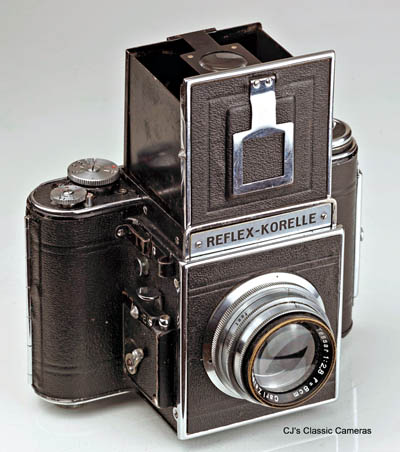
| |
A Reflex Korelle II with slow speed dial and a Carl Zeiss Tessar 80mm f/2.8 lens. The serial number indicates that the lens is from 1938, and presumably so is the camera. |
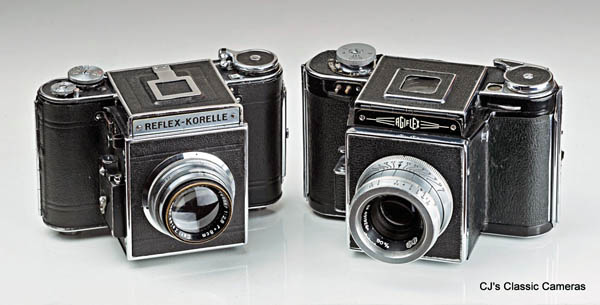
The Reflex Korelle was clearly the inspiration for the British-made Agilux Agiflex, which was introduced just after WWII. Here the two can be seen side by side. The Agiflex was actually slighty larger. More details in the Agiflex section.
KW Pilot Super
KW made interesting cameras, and the Pilot Super was no exception. It was a very compact medium format single lens reflex camera produced in the late 1930s. The shutter was an interesting design where the mirror basically served as the front curtain, exposing the film whilst moving upwards when firing the shutter, then followed by the second 'curtain' at a preset distance from the first one based on the shutter speed selected. Another interesting feature was the extinction meter mounted on the viewing hood, so one could read off the exposure setting. An exposure table was printed at the side of the camera for that purpose. Note this wasn't present on all Pilots, but it is on the example shown below.
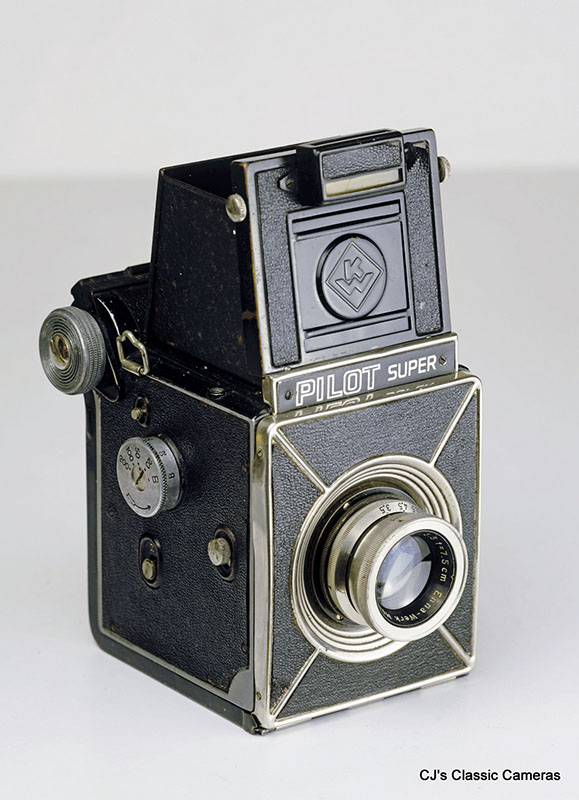
| |
A KW Pilot Super with Enna-Werk Munchen Ennatar 75mm f/3.5 lens with its viewing hood open.
|
The lens was removable, and according the manual other focal lengths were available, but these are extremely rare. Perhaps the main reason for this mount was simply to easily supply the camera with the lens the customer wanted.
Due to its single reflex design and relatively simple shutter, this is one of the smallest and lightest medium format cameras I own, and quite a step up in terms of versatility and usability compared to the more common box cameras that were popular at the time.
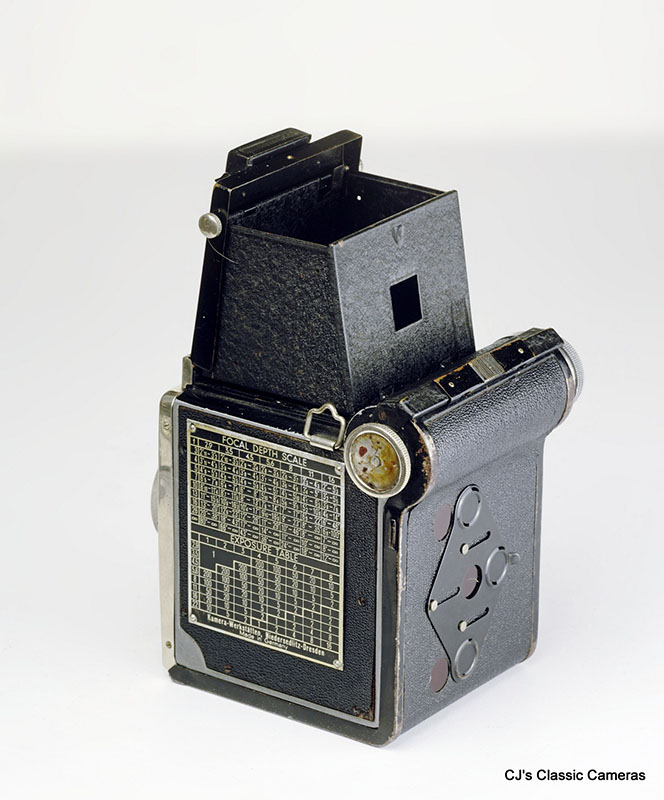
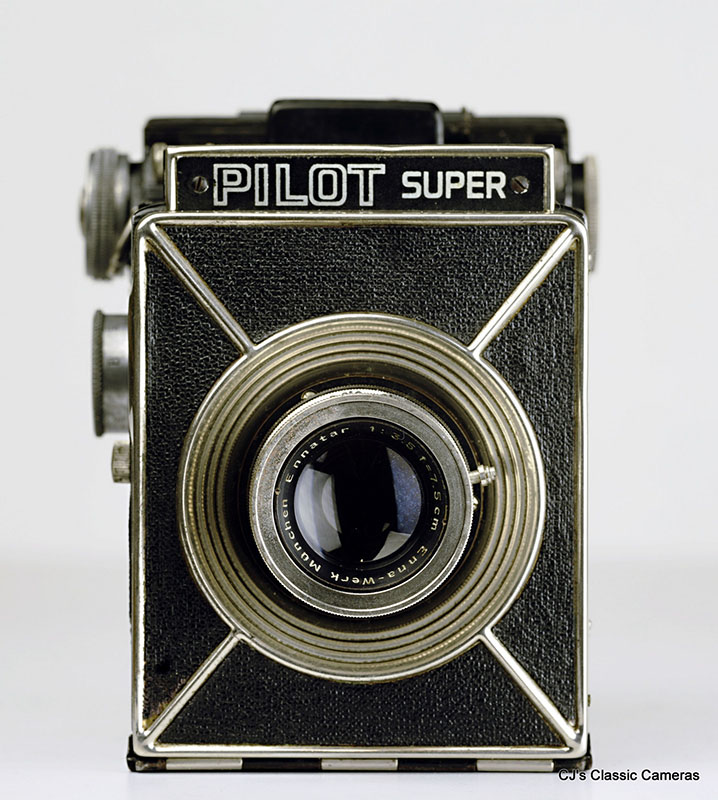
(left) Rear view of the Pilot Super. Note the three red spy windows - the camera could also be used as a 6x4 format camera by using an interchangeable mask (not present with this camera), for which the two extra spy windows were needed.
(right) Front view of the Pilot Super.
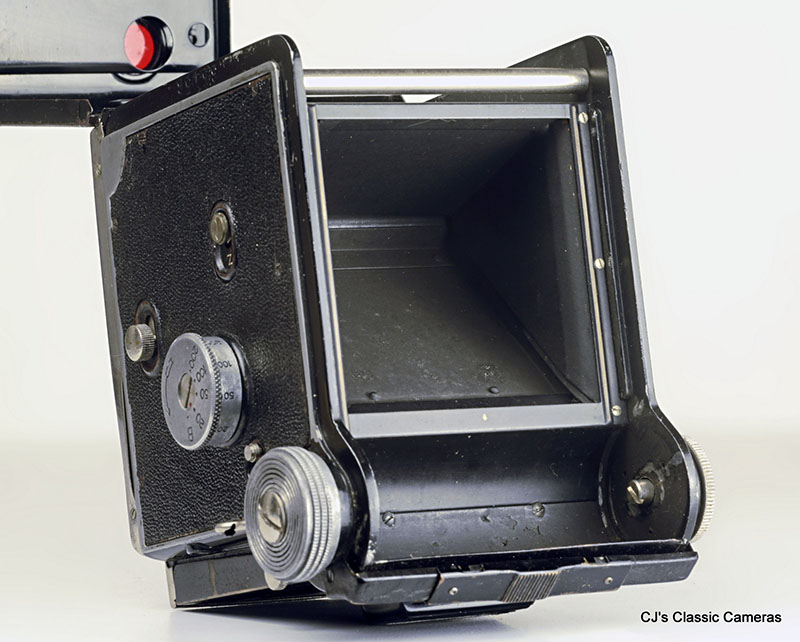
| |
Interior of the film chamber with the camera upside down and the mirror down. Upon pushing the shutter release button, the mirror would move up and open a gap to to expose the film, then the second curtain would appear out of the bottom part of the film chamber.
|
Zeiss Ikon Contax-S
The introduction of the pentaprism SLR started a new era in photography. There's been a fair amount of discussion on the internet which was the first pentaprism SLR camera, the Italian Rectaflex from the relatively unknown camera maker Telemaco Corsi, or the Contax-S from the mighty Zeiss Ikon. The debate appears to have settled on the Rectaflex being the first on the market in 1948, and the Contax-S being the earlier prototype with development starting in 1938 already.

A Zeiss Ikon Contax-S, simply marked as 'Contax' on the front of the camera, with a Carl Zeiss Jena Biotar 58mm f/2 lens. Early production had no self timers.
SLRs cameras had been available well before, the Ihagee Exakta range for example, but these had waist-level finders, which mirrored the image and weren't very bright. The ingenious design of the pentaprism projected the image correctly, as one would see it through a normal viewfinder, and in addition it illuminated the view more evenly and appeared brighter. The design was so effective that it is still in use today, over 70 years later.
The choice of Zeiss Ikon to name the camera 'Contax' is interesting, as it was a significant departure from their rangefinders with the same name, and had little in common other than the name. It had a horizontal moving cloth shutter instead of a vertical metal shutter, a hinged back door instead of a removable back, and even details like wind knobs were different.
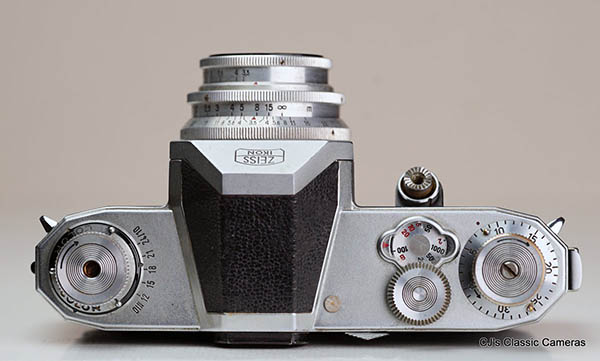
Top view of the Zeiss Ikon Contax-S (with a different lens mounted than in the picture above, a f/3.5 Tessar), looking very different from anything Zeiss had made before.
The Contax-S introduced another first: the M42 screw mount, later known as Practica mount and probably the most popular interchangeable lens mount ever used. After a few years it was updated to the Contax D, which wasn't all that different, mainly the flash contact had moved from the bottom to the top of the camera. Initially it was only marked by a small capital 'D' beneath the Zeiss Ikon logo on the pentaprism, but later the name was marked as Contax D on the front of the camera.
Pentacon F
The Pentacon SLRs were made by the former Zeiss Ikon factories in Dresden, which in the late 1950s merged with several other companies and was renamed VEB Pentacon due to legal disputed with the new Zeiss Ikon company in West Germany. It produced the Contax SLR (see above), but was soon after renamed Pentacon for the same legal reasons.
The Pentacon F was first introduced in 1957 and was the successor of the Contax D. It's main new development was the semi-automatic aperture, which set the aperture to a preselected value while cocking the shutter. This avoided have to fiddle with the aperture after focussing the lens.

A Pentacon F displayed with a Carl Zeiss Jena Tessar 50mm f/2.8 lens. It was very similar to the earlier Contax-S, shown earlier. The main difference were the wind knobs, which somewhat ironically were more 'Zeiss Ikon' like than on the Contax-S. The Pentacon logo on the front can also be found on the Pentona II elsewhere on this site.
KW Praktica
The KW Praktica was one of the first SLR cameras on the market and sort of a poor man's Exakta. It was a further development by Kamera Werkstatten (KW) of its first SLR, the Praktiflex, introduced in 1939. KW was based in Dresden and had developed some innovative cameras in the early 1930s, including the Pilot Reflex, a small handsome TLR camera. After WWII KW resumed production fairly quickly and introduced the Praktica with M42 screw mount, which mount had only recently been introduced with the Zeiss Ikon Contax S. The Praktica was a great succes and soon after followed a whole range of Praktica SLRs, which lasted until well in the 1990s (as part of VEB Pentacon).
The 1949 Praktica was a fairly simple SLR camera with a non-interchangeable waist-level viewfinder, a wind knob and a fastest speed of 1/500s. It was relatively cheap and reliable. A separate pentaprism viewfinder which could be mounted on top of the waist-level viewfinder was available as an option.

An early version of the KW Praktica, recognisable by its integrated strap lugs, with coated CZJ Tessar 50mm f3.5 lens. The waist-level viewfinder could also function as a so-called sportsfinder by opening the flap with the KW logo on it.

Detailed view of the top of the KW Praktica showing the waist-level viewfinder unit with magnifier. Also note the shutter speed dial, the top dial of which functioned as the slow and fast speed selector. If it pointed to the black triangle, the black numbers applied, and if it pointed to the red triangle, the (slow) red numbers applied. The speed itself was indicated by a small red dot on the lower ring.
Praktica V F
After KW was amalgamated into VEB Pentacon, the Praktica finally received a pentaprism as standard, even though it had already been on their more advanced Praktina (see below) for many years. The first model of these was the Praktica IV in 1959, so 10 years after the introduction of the original Praktica. Perhaps to make up for the lack of one earlier, the Praktica had de largest pentaprism 'bulge' I have seen on any camera. But other than that, the camera was still very similar to the earliest Praktica, as can be seen by comparing photos of the 1965 Praktica V F below and the original Praktica above. Of course it had new features, such as an instant return mirror and a rapid winder in addition to the knob winder, but overall it started to fall behind compared to what was coming out of Japan by then.
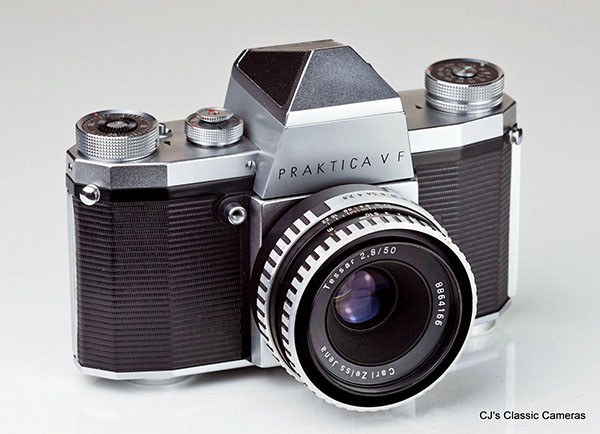
A Praktica V F with Carl Zeiss Jena Tessar 50mm f/2.8 lens. Note the large pentaprism hump, which even leans a little forward.
KW Praktina
The 1954 Praktina was a more advanced model of Kamera Werkstatten's Practica, described above. It was highly adaptable, having interchangeable viewfinder, focussing screen and camera back, as well as a provision to mount a motor wind. In addition, the Praktina had a revolutionary feature: automatic aperture control, which allowed to focus at maximum aperture but would automatically stop down to the selected aperture upon firing the shutter. Of course this was also available on the Ihagee Exakta Varex, but there it was done on the lens whereas on the Praktina it was implemented in the body. Moreover, the Praktina took it a step further. On early models (the Praktina FX) one still had to open the aperture manually after shooting, but on the 1958 Praktina IIA the aperture would be opened during film winding (on lenses that allowed this feature), so one never had to worry about it anymore.
A peculiar feature of the Praktina was the presence of a direct viewfinder in addition to the through-the-lens viewfinder. It was brighter so useful in low light, and would not blank out during shutter release, one of the drawbacks of SLR cameras without automatic mirror return.
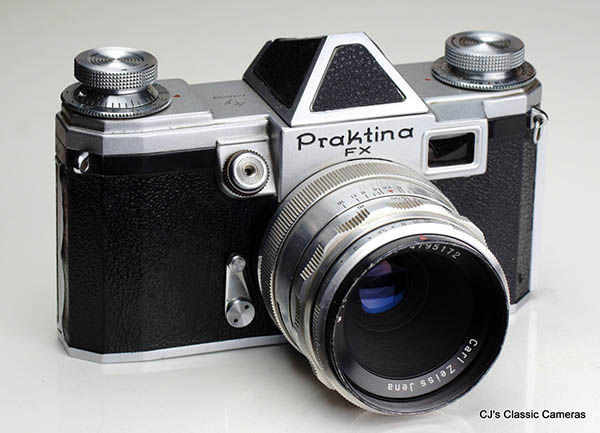
A KW Praktina FX with Carl Zeiss Jena Tessar 50mm f/2 lens with semi-automatic aperture control. I believe this to be a Praktina FX-SA3 version 2 according the praktina.com website, as it has a film reminder dial with both DIN and ASA film speed settings.
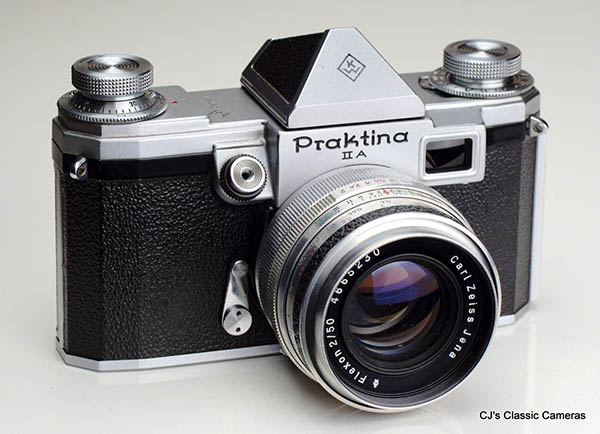
A KW Praktina IIA with Carl Zeiss Jena Flexon 50mm f/2 lens with fully automatic aperture control. This is a Praktina IIA-A version 2 according the praktina.com website.
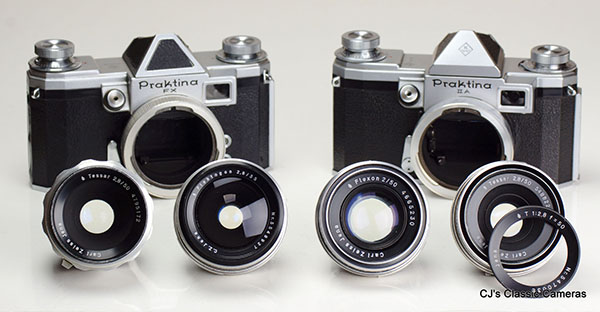
Two KW Praktinas with various lenses, including a wide-angle 35mm f/2.8 Flektogon . The one on the right is quite curious. It's marked Jena T, which is what the original East German Carl Zeiss factory called their Tessars after they lost the trademark in a dispute over the rights of the name with Zeiss Ikon, the new West German branch. I removed the front ring from this lens in an attempt to clean the front cell, only to find out there was a second ring beneath it marked Carl Zeiss Jena Tessar and sporting a different serial number. So the ring looks like a quick patch after Carl Zeiss Jena lost the rights to their name. Curiously, the Flektogon has a later serial# but still carries the name C.Z. Jena.
KW Praktisix IIA
The KW Praktisix was introduced in 1957 and was one of the earliest medium format SLRs which handled more or less like a regular 35mm camera. It had a wind lever to transport the film and cock the shutter, and most other functions were in familiar places, especially if one was used to the KW Praktina above. It was available with a waist finder or a reflex finder; the latter could also be equipped with a through-the-lens light meter unit. The camera also featured automatic aperture control, so it would stop down to the pre-set aperture when pushing the shutter release. It had a cloth focal plane shutter. All in all a great, easy-to-use camera, apart from one thing: it was huge!
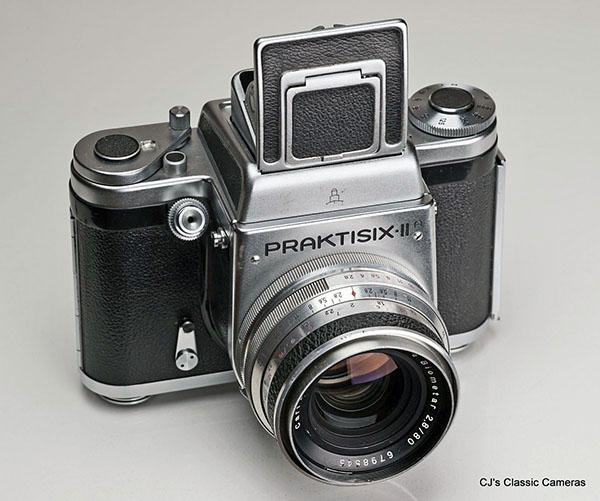
A KW Praktisix IIA with Carl Zeiss Jena Biometar 80mm f/2.8 lens and waist-level finder.


The Praktisix was a successful range of cameras, but it evolved only little during the two decades or so it was in production. The first model was made by KW before it got amalgamated into VEB and later Pentacon. Early production shows the KW logo, whereas later production already shows the Pentacon symbol. The Praktisix II was introduced in 1964 but any modifications were merely incremental, and the IIA, which is the model seen above, again only differed little, one addition being a film speed reminder on the back of the camera. In 1966 the name was changed to Pentacon Six (see next).
A KW Praktisix IIA with Carl Zeiss Jena Biometar 80mm f/2.8 lens with semi-automatic aperture control.
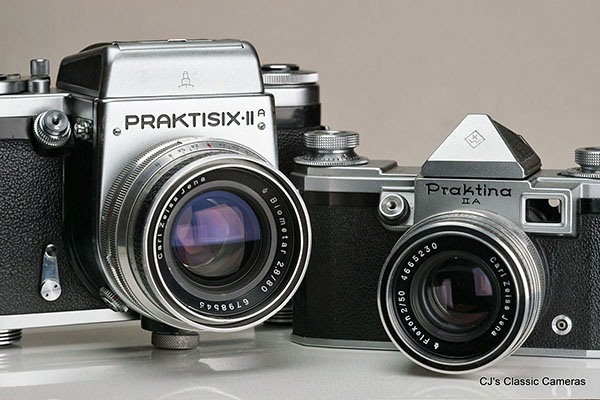
Big brother and its much smaller sibling. Note the similarities, including the design of the lens, position of shutter release button, and so on.
Pentacon Six
The Pentacon Six was the successor of the Praktisix introduced above. On this model the film transport was upgraded to make it more reliable, as it had been a bit of a weak point of the Praktisix. It was further developed into the Pentacon six TL, the final model, which was in production until the late 1980s. The change was mostly in the name, to signify the release of a TTL metering prism. So the final variant still looked a lot like the first Praktisix variant from the late 1950s, which serves as a big compliment to the quality and longevity of the original design.
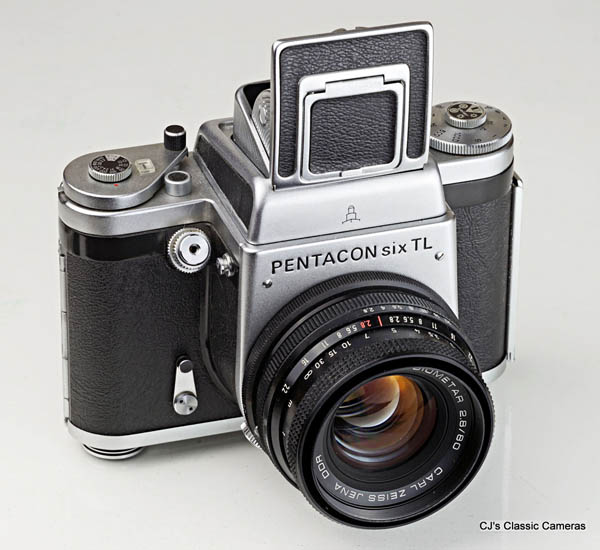
A Pentacon six TL with Carl Zeiss Jena Biometar 80mm f/2.8 lens. As one can see, externally it differs very little from the Praktisix IIa above. The lens was essentially the same as well, although the chrome was replaced by black metal and plastic, and it looks like the lens coating was different.
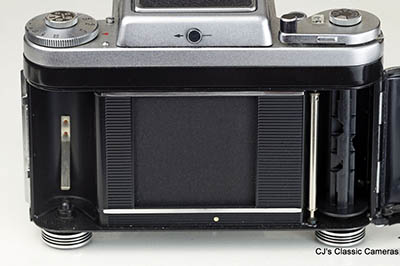
| |
Inside view of a Pentacon six TL showing the film transport and shutter blinds. Like the Agfa Super Isolette, the Pentacon Six had a toothed wheel feeler to control how far the film was transported, so you'll notice a string of small holes at the edge of your negatives. |
Kalimar Reflex
The 1957 Kalimar Reflex was built by Fujita and was an improved version of the earlier Fujita 66 and Soligor 66. Although technically an SLR, it handled very much like the TLR cameras above, the main difference being the mirror which was not fixed (to a viewing lens), but retractable and therefore could use the taking lens as viewing lens. The system is best known from the Hasselblads. A focal plane shutter was used to make this setup possible (as a leaf shutter would block the view). Other than that, one would wind the film with a knob on the side and view the image from the top through a hood with a frosted glass, very much like most TLRs. The Kalimar Reflex also featured an instant return mirror, making the experience even more similar to a TLR.
One important difference was the ability to change lenses, which is simpler to implement on a system like this than on TLRs, as one didn't have to worry about different viewing and taking lenses. In fact, the Kalimar had a 52mm wide angle lens available, one of the few medium format SLR systems to do so. The lens mount was a 46mm screw mount.
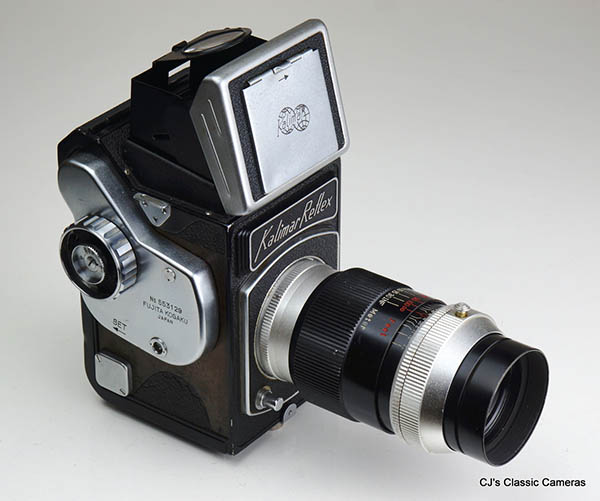
A Kalimar Reflex with Kaligar 150mm f/4 lens. This is not the standard lens for this system, as that would be the 80mm f/3.5, which I do not have.
Arsenal Zenith 80
The Zenith 80 was a close copy of the iconic early Hasselblads, the 1600F and 1000F, and therefore sometimes jokingly referred to as a Hasselbladski. It was made by Arsenal, the producer of Kiev cameras, not to be confused with KMZ, who made the Zenit (and Zorki) cameras. The Zenith 80 was the UK export version of the Salyut, the only difference being the wind knob, which was chrome on the Salyut, but had a 'zebra pattern' on the Zenith 80. A few more very similar cameras were produced, namely the Salyut-C and its export twin the Kiev 80, as well as the Kiev 88 which featured a prism finder instead of a waist level finder. To add to the confusion, these have several slightly different lens mounts.
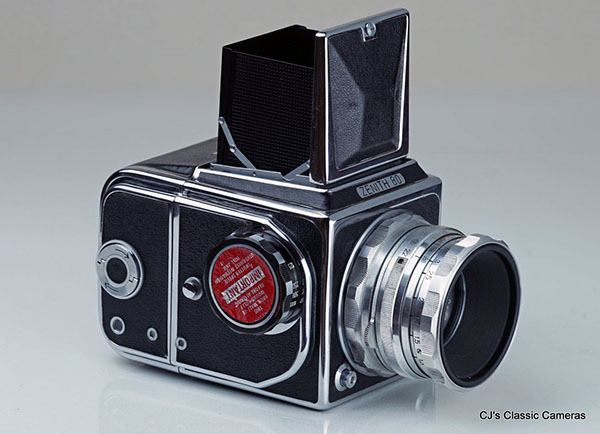
Arsenal Kiev Zenith 80 with Industar-29 80mm f/2.8 lens. This lens had a cool conical filter mount that allowed small filters to be mounted deeply recessed just in front of the front element. Note the big red warning sticker on the wind knob to alert people to only change the shutter speed after winding, otherwise damage may occur but also, the camera won't wind on properly.
Like its inspiration the Hasselblad, the Zenith 80 had a modular design with removable film back, viewfinder and lens. In principle this would allow great flexibility but in reality there were only few lenses for the Zenith 80 and only one viewfinder. The lens mount was also slightly modified on the later models, so that lenses for those can only be used in stopped down mode on the Zenith 80.
Nevertheless, it was an impressive camera. The film would be advanced and the shutter cocked with one full turn of the wind knob. This knob also doubled as a speed selector, which should only be done after winding the film. The shutter was of the focal plane type and was made of metal (as on the early Hasselblads, later Hasselblads had lens-mounted leaf shutters). It had a top speed of 1/1000s but also allowed long exposures up to 1s. The lens had an automatic stop-down aperture. The camera had an interlock so one could only remove the film back with the dark slide in place, and the shutter could not be fired if the dark slide was accidentally left in.

Rear view of the Zenith 80 with the film back removed. Note the gold-coloured metal shutter curtains, which are quite fragile as the various dents show. It also makes a lot of noise when fired. On the right side of the rear of the camera from bottom to top one can see the dark slide interlock, the drive wheel for the film advance that couples to the film back, and a small pin to reset the film advance sprocket on the film back after winding.

| |
A view in the throat of the Zenith 80 with the internal light baffles removed to expose the shutter and wind mechanisms. Bottom right is the slow speed mechanism, whereas the large perforated wheel in the centre is part of the shutter timing mechanism. Visible in the back are the shutter release mechanism, the brass wind axle and the mirror mechanism. The main issue with working on these cameras is that all the different mechanisms have to synchronise very precisely, and it is easy to get it wrong.
|
Zenit-C
The Zenit line of SLR cameras was introduced in the early 1950s by KMZ, the maker of the Zorki Leica copies, and started in fact off as a Zorki II which had been converted to an SLR model by adding a groundglass screen and a mirror. It kept the same L39 screw mount but the flange distance increased to make room for the mirror, so lenses are not interchangeable between the two mounts. It's also slightly different than the Braun Paxette mount, which also uses a 39mm screw mount. Other than the pentaprism it handled almost identical to the Zorkis, including bottom loading of the film.
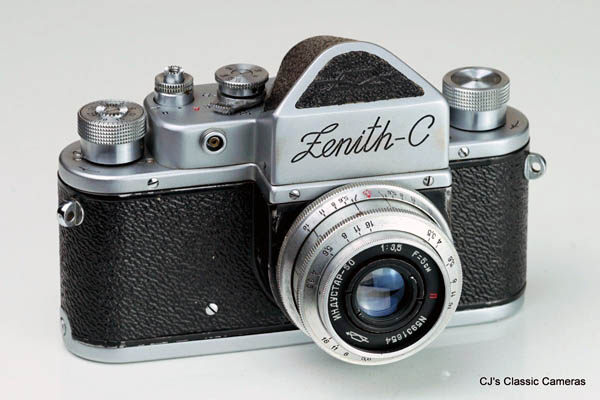
An Zenit-C with an Industar-50 50mm f/3.5 lens. The Zorki II origin of this early SLR is clearly visible; all controls are virtually identical, only the rangefinder is replaced by a bulbous pentaprism and the lens mount has been extended to make room for the mirror. Nevertheless, it is one of the smallest SLRs one can find. The Russian (Cyrillic) letter C is equivalent to our letter S and stood for 'synchronised', i.e., flash-enabled.
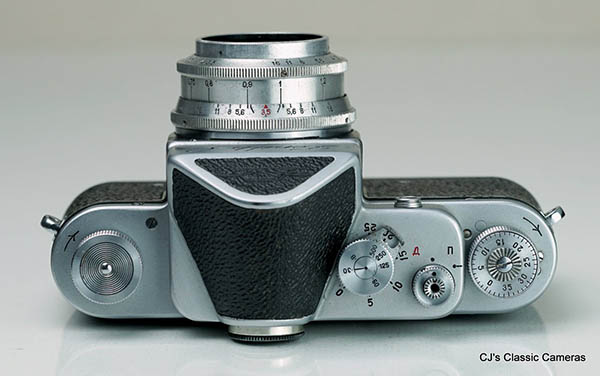
Top view of the Zenit-C. I don't have a Zorki II, so can't show a direct comparison, but it's still rather similar in layout to my Zorki 4K rangefinder.
Zenit 3M
In 1960 the Zenit-3 replaced the Zenit-C, and featured a film advance lever instead of a wind knob as well as an new top housing made of one piece. It was still bottom loading (like most Leica copies), this was however changed to a hinged back on the Zenit-3M, like the one shown below.
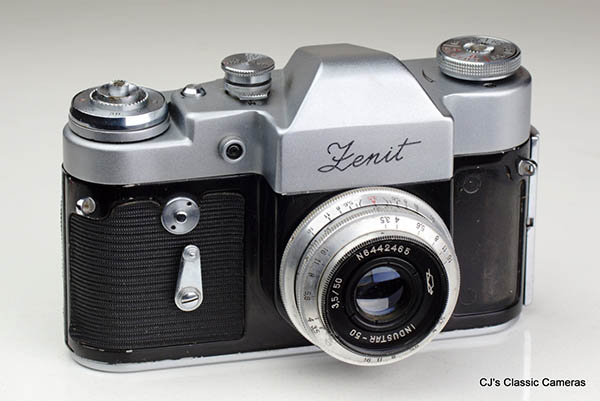
An Zenit 3M from 1966, assuming the serial# starts with the year of production. It is fitted with an Industar-50 50mm f/3.5 lens. It is not a particular advanced camera for its time, lacking slow shutter speeds and having a top 1/500s speed, no lightmeter or automatic diaphragm, etc. But that also means not much can go wrong with it, and indeed it still works quite smoothly.
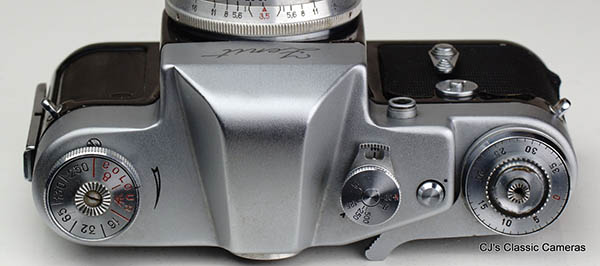
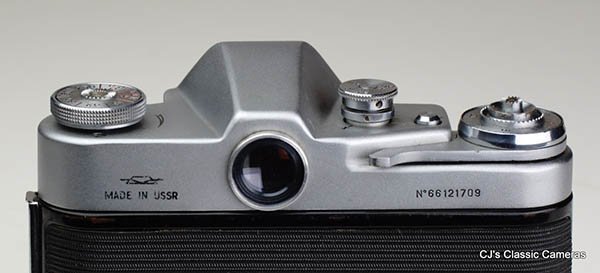
Top and rear views of the Zenit 3M, showing off its unassuming and functional design. One neat feature of this otherwise fairly low-spec model was the mirror lock-up button in-between the wind-lever and speed dial: push it once and the mirror would lock up, push it twice and the shutter would fire. A similar way of avoiding mirror shake could be achieved with the time delay button, as it would lock up the mirror several seconds before opening the shutter.
Zenit-E
The 1965 Zenit-E was one of the first completely redesigned Zenit models so they no longer resembled rangefinders with a mirror box and pentaprism bolted on, like the earlier models . The Zenit-E also had a lightmeter and in 1967 the lens mount was changed to the more practical m42 mount. The Zenit-E was a popular camera and reportedly over 3 million of them were made, with production continuing until 1986. Many more generations were to follow; the Zenits were a great succes with production in the tens of millions, and as recently as the early 2000s.
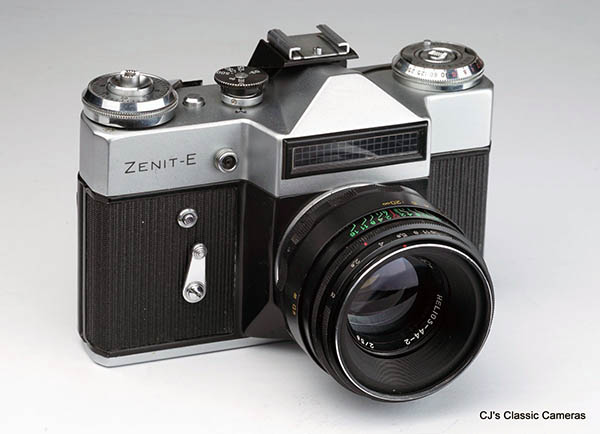
A Zenit-E with Helios-44-2 58mm f/2 lens.
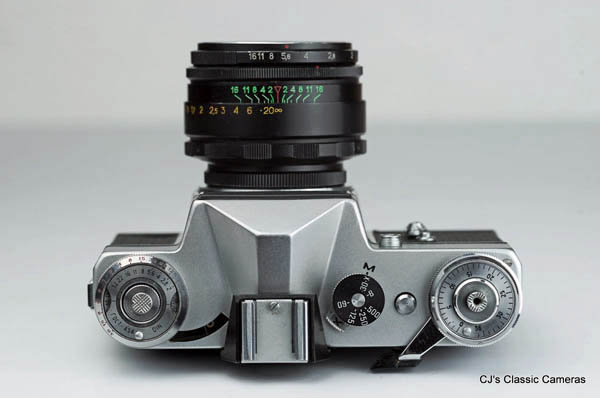
Top view of the Zenit-E, probably its best angle!
KMZ Start
From the makers of the Zenit also came the KMZ Start, which was a high-quality SLR camera introduced in 1958 that boasted features like an interchangeable viewfinder, automatic aperture control (allowing focussing at full aperture, stopping down during shutter release) and of course an interchangeable lens mount. The latter turns out to be almost a gimmick, as only one lens was available for this model: a Helios-44. It's sometimes presented as the Russian equivalent of the Ihagee Exakta although personally it reminds me more of the Wirgin Edixa flex models. It does feature a film cutter though, which allows you do develop part of the film only if needed, and this was a typical Exakta feature.

A KMZ Start from 1960 destined for the Russian internal market, hence the cyrillic script of the name. Export version were called 'Start'. It's equipped with the standard Helios-44 58mm f/2 lens, an impressive looking lens which in all likelyhood is a Carl Zeiss Biotar copy.
The fact that only one lens was available already tells you that this camera never was very popular. Apparently there were also some reliability issues. I've experienced that myself, as my example's wind-on is very rough and gritty. I dismantled, cleaned and relubricated the whole thing, only for it to make no difference at all. There's a sort of clutch in the mechanism and when I disconnect it, the wind lever feels fine and the shutter also cocks fine (by hand, as it was disconnected from the wind lever). But connect the two and it is problematic again. Of course you can't really judge a 60 year old camera, but most mechanical cameras destined for the pro market can be revived with good care. Unfortunately, this one is going to stay on the shelf.
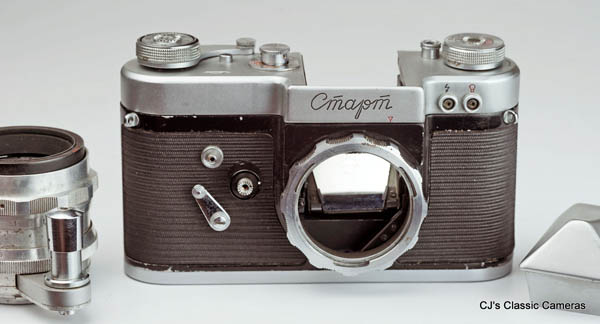
A KMZ Start body with its viewfinder removed, showing the breach lens mount.
Asahi Pentax
Pentax is probably the biggest camera brand of which I didn't have a single camera for a very long time, due to the fact they only ever made SLR cameras, which I generally don't tend to collect. Most well-known SLR brands such as Minolta, Canon, Nikon, Olympus started out making folding cameras or 35mm rangefinders, as I have documented elsewhere on this site, but not Pentax,or rather Asahi, which is the company that it started as. Asahi was an optical company that after WWII decided to expand into the camera industry, and reckoned that the relatively new SLR cameras were to way to go. Thus, they build a copy of the KW Praktiflex, the 1952 Asahiflex, which had a waist-level viewfinder. They named their first pentaprism model the Pentax, and the rest is history. The decision to get into SLRs was absolutely the right one, and Pentax developed into one of the most successful camera brands. However, they did no do as well with the transition to the digital era, and Pentax was sold off to Ricoh in 2011, which still continues the use of the brand name and produces several high-quality DSLRs.

Asahi Pentax S1a with Asahi Super Takumar 55mm f/2 lens and accessory flash shoe mounted. There are a lot of early Pentax models with small incremental changes, but from the start they had instant return mirrors, advance levers and a back that opened as a door, and quite quickly gained automatic aperture stop-down, which put them ahead of all their competitors.
On a more personal note, my first introduction to an SLR camera (in the early 1990s) was in fact a Pentax. My girlfriend at the time had a fully manual Spotmatic and we used it extensively on our many trips. I didn't really have a proper camera and it was only when I was going on fieldwork in Indonesia by myself that I decided I should have my own camera. This ended up being a Minolta 500si, which had the benefit of having autofocus, and because Minolta was considered the poor-man's Canon or Nikon, which I as a student couldn't afford! My current use of Sony cameras is still the result of the ad-hoc decision I made at the time.
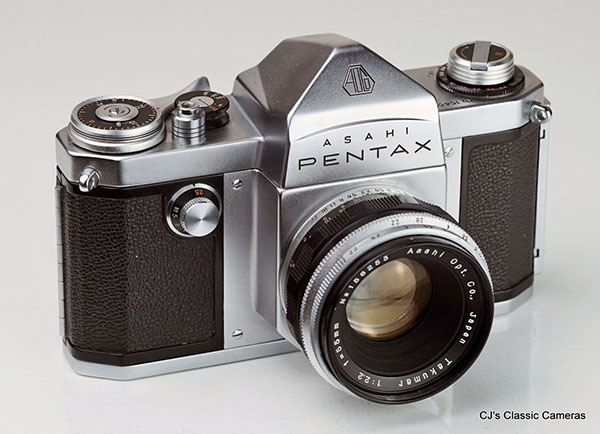
Early Asahi Pentax S with Asahi Super Takumar 55mm f/2.2 lens that I fixed for a client. I didn't really appreciate it at the time, but this is a pretty rare model. Only the first few Pentax models had a separate slow-speed dial on the front of the camera, a feature more commonly found on rangefinders such as the Leica III and many of its copies.
Nikon F
There is not much I can say about Nikon that hasn't been said before. It is one of the most well-known camera brands and probably the most well-reputed of the big brands. The Nikon F was its first SLR and was introduced in 1959, so a little later to the market than some of its competitors, but to make up for that the Nikon F was the most advanced SLR on the market when it arrived. Its design was based on that of the Nikon SP, its iconic rangefinder, essentially only adding a mirror box, a bayonet mount and a pentaprism that that body, but it had many innovative features including an instant return mirror, a 100% viewfinder image, automatic aperture control as well as the option to add a motor drive and a TTL lightmeter prism. So it was no surprise it made an immediate impact and set the standard for professional SLR cameras ever since.
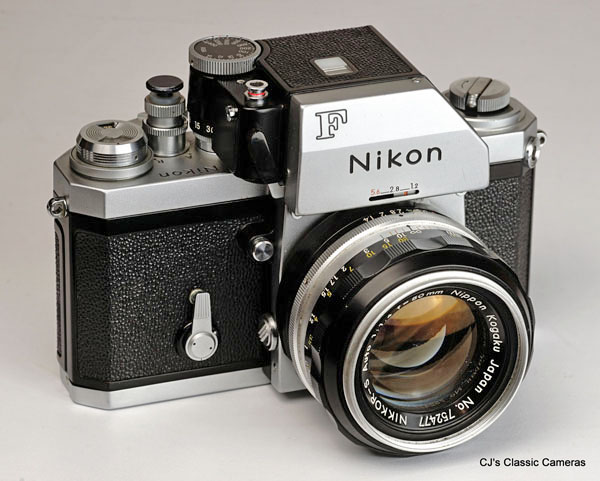
A Nikon F Photomic with Nikkor-S Auto 50mm f/1.4 lens. The Photomic prism functions as a coupled lightmeter that allows automatic shutter speed and aperture control, which is great but it does make the camera look rather bulky. The Photomic can be replaced by a much smaller regular pentaprism, but these are scarce and therefore, rather ironically, considerably more expensive these days.
The Nikon bayonet mount is one of the few lens mounts that has survived till the modern day, proof of its well thought-out design that allowed for improvements over time whilst still maintaining backward compatibility.
If you want more detail about the history of the Nikon-F development, you could do worse than learning it from the company itself. It has an interesting comment on the name Nikon F, which they say was chosen because non-English speakers have difficulty pronouncing the letter R from Reflex, and therefore they settled on the letter F instead (from reFlex).
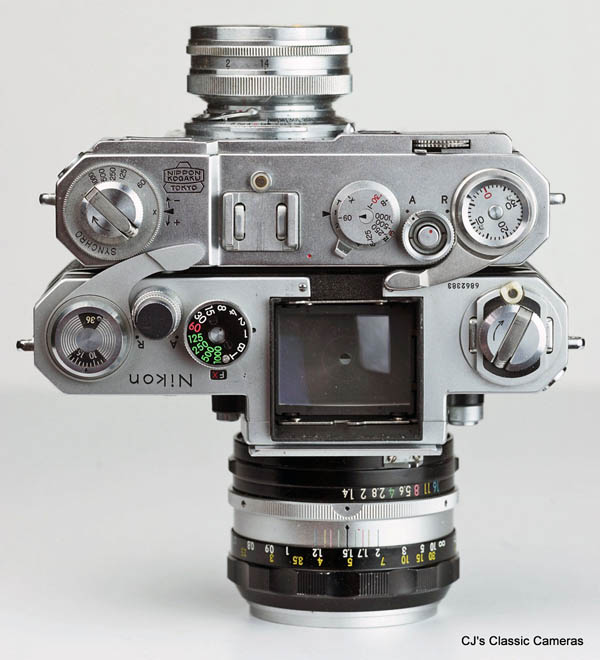
Top view of the Nikon F carrying a Nikon S2 rangefinder on its back for comparison. The Nikon-F body was based on that of the Nikon SP rangefinder, but the similarities with the older S2 are also clear. Note the difference in lenses on both bodies, both 50 mm f/1.4 lenses, but the SLR version being much bulkier. One reason is that the focus mechanism was different; the rangefinder had a body-mounted helicoid, whereas the SLR version has it's own focus helicoid. But the SLR lens also has consirably more glass and a different optical formula (Gauss-type instead of Sonnar-based) to deal with the larger distance from the film frame due to size of the SLR's mirror box. For the same reason (larger distance to film frame), the first f/1.4 lens designed for the Nikon F had a 58 mm focal length, and was by Nikon's own admission somewhat inferior its older rangefinder sibbling. A further redesign led to the 50mm f/1.4 as seen in the photo above, which reached similar quality to that of the rangefinder version.
Which one would you rather have hanging around your neck all day?
Nikon FM2n
The Nikon FM2n was introduced in 1982, which makes it one of the most modern cameras on this site, and it was one of Nikon's last fully manual exposure cameras. By this time focal plane shutter design had developed to a stage where cloth shutter blinds had been replaced by metal blade shutters that scissored vertically across the film frame. This made shutter movement more reliable and faster, allowing faster shutter speeds, like 1/4000 on the FM2. It also made possible fast flash sync speeds of 1/200s, previously only possible with leaf shutter. The 'n' in the name stands for the new version, which was introduced in 1984, and had an even faster flash sync speed of 1/250s. It was produced until 2001.
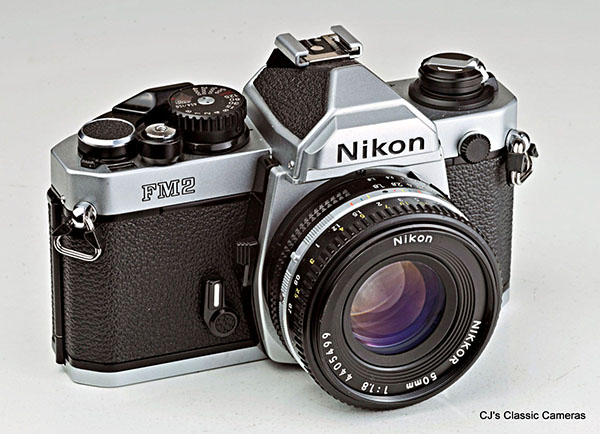
A Nikon FM2n with Nikkor 50mm f/1.8 AIS 'new' lens from 2005. This lens no longer had the aperture prong first found on the very first SLR pre-AIs Nikkors, but also on much later AIS ones for backwards compatibility. However, it still featured two rows of aperture markings.
Miranda DR
Miranda is not a name many people recognise as a camera maker nowadays, but from the mid 50s up to the 70s it was a well-known brand mostly for its SLR cameras. The first Miranda SLR was introduced in 1955 and was one of the earliest companies to do so. Initially the Mirandas developed quickly, new models came out each year and by 1961 the cameras had wind lever, lenses that stopped down automatically when releasing the shutter, interchangeable viewfinders and instant return mirrors. These were the features of the Miranda DR, the last model before models with lightmeter were introduced (initially as uncoupled prism meters). Unlike most other manufacturers, Miranda did not make their own lenses, but used other companies, in particular Soligor. The company stopped trading in the late 1970s but left a legacy of high-quality, innovative and user-friendly SLRs.
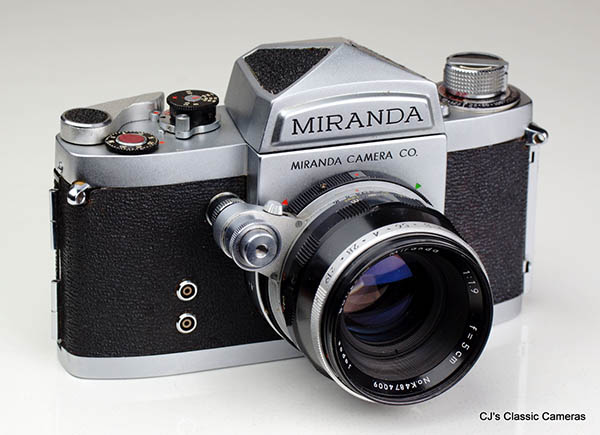
A Miranda DR with Miranda Soligor 55mm f/1.9 PAD (pressure activated diaphragm, borrowed from Exakta) lens.
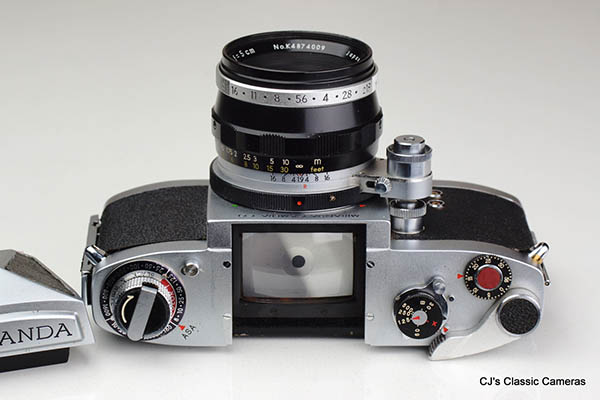
One of the interesting features of the Miranda (although by no means unique, but certainly uncommon amongst Japanese SLRs) was the interchangeable viewfinder.
Canon Pellix
Canon won't need much of an introduction, it is the largest camera maker in the world. However, it was relatively late in the SLR game; when its 1959 Canonflex was finally introduced their were already eight competing models on the market, and it wasn't until the 1964 Canon FX that Canon's SLR range started to gain in popularity, still mostly with amateur photographers. Canon's first succesful professional SLR, the F-1, wasn't introduced until 1971, together with the FD lens mount which allowed open-aperture metering and full-auto exposure.
A Canon SLR that deserves a special mention is the 1965 Canon Pellix. This camera had a rather unique feature, but it was soon abandonned and forgotten, until it was reintroduced about a decade ago by Sony on their digital SLR cameras. This special feature was a fixed semitransparant or pellicle mirror, which replaced the normal 'swing up' SLR mirror, and was essentially a beam splitter that reflected part of the light that entered the camera through the lens onto the viewfinder and the remainder of the light onto the film. Compared to regular swing up mirrors this construction was simpler, reduced camera shake, and avoided blackout of the viewfinder during firing the shutter.
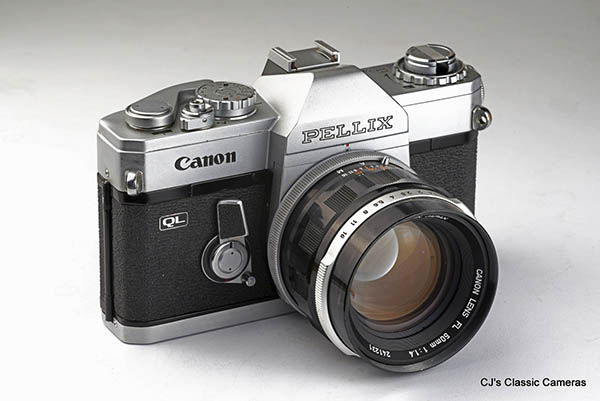
A Canon Pellix with FL 50mm f/1.4 lens. Fast aperture lenses were recommended for this camera to compensate for the reduced brightness of the viewfinder.
The drawback was that the viewfinder was more dim and that less light reached the film, so exposures needed to be longer. These drawbacks outweighed the benefits at that time, and the Pellix experiment was discontinued after a few years. Until Sony reintroduced it many decades later in its digital SLRs allowing continuous autofocus and lightmetering. As these cameras were equipped with electronic viewfinders, the reduced light was no longer an issue. Nevertheless, digital SLRs have now largely been replaced by mirrorless cameras, so completely lacking any mirror, which have much reduced body sizes and very short registers (distance between base of the lens mount and the sensor), allowing the use of vintage rangefinder lenses using mount adapters.
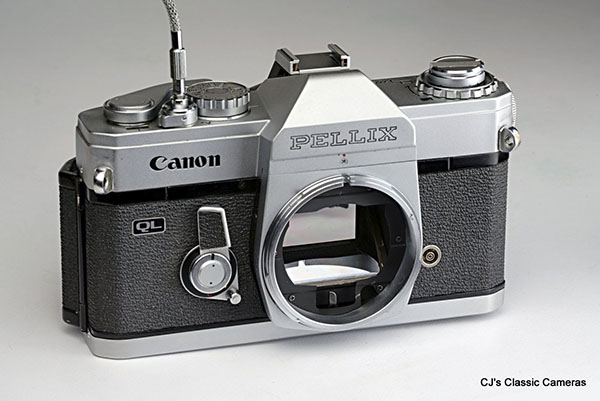
A Canon Pellix body showing the mirror box and an attempt to show the mirror itself, which isn't easy as it is barely visible. I've opened the shutter, with the film opening clearly visible through the semitransparent mirror whilst a bright reflection shows the bottom part of the mirror itself.
Another benefit of the fixed mirror of the Canon was that it allowed lenses to protrude a little into the mirror box. This was used effectively with the Canon FLP 38 mm f/2.8 lens, which was a compact wide angle lens with a straightforward optical design as opposed to the retrofocus design that was required on other SLRs. This was the only lens made especially for the Pellix (hence the designation FLP), it otherwise used regular FL lenses. I suppose Canon could have made the camera thinner, but then all lenses would have to be redesigned or an adapter mounted, defeating its purpose.
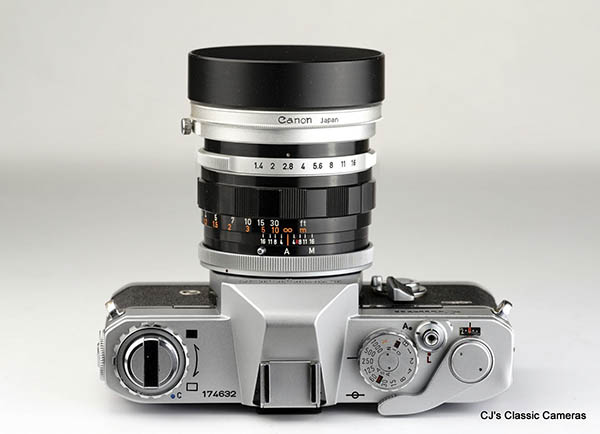
Top view of the Canon Pellix with its dedicated lens hood also mounted.
Canon AT-1
In 1976 the Canon A series was introduced, a range of SLRs electronically controlled shutters and through the lens (TTL) metering. The 1977 AT-1 was a cheaper export version of the hugely popular AE-1 without an automatic exposure mode. It featured match-needle metering with the needle visible in the viewfinder (nothing new, already available nearly 20 years earlier on the Voigtlander Vitomatic range, but why change a good concept?). Top shutter speed was 1/1000s, not particularly impressive. I think it is clear that by this time, camera manufacturing mostly focussed on optimising production for maximum efficiency and lowest price (whilst maintaining reliability), which was needed for most camera makers to survive. The one major development still waiting to happen was autofocus, which was first implemented in a 35mm SLR camera by Pentax in their 1981 ME-F and was soon universally adopted. On the bright side, this focus on cheap mass production was the reason I was able to pick up my first SLR as a university student, a luxury most students a few decades earlier wouldn't have been able to afford!
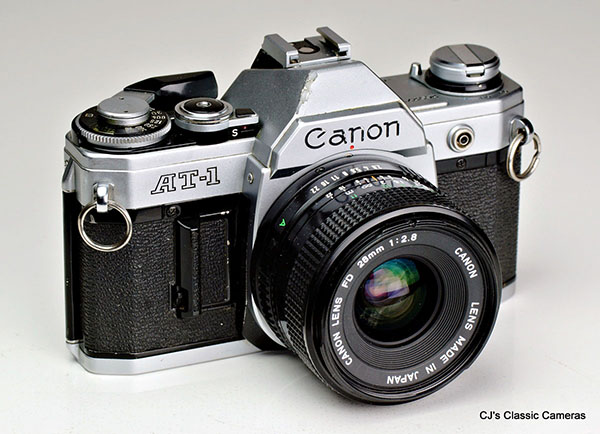
A Canon AT-1 with Canon 28mm f/2.8 FD lens. This example sustained some impact damage on the viewfinder top, which exposes the plastic it was made of... but nevertheless it is still running smoothly. The FD lens range was superseded by the autofocus EOS range, but they had excellent optics and would be a good and affordable choice of lens if you wanted to try out manual focus lenses on modern camera bodies (using the right adapter).
Polaroid SLR 680
Polaroid is one of the most recognisable names in photography, but perhaps more so due to those iconic instant photographs with thick white borders which used to cover people's refrigerators and pin boards than as a brand of cameras. The instant camera was developed in the 1940 by Edwin Land, the founder of Polaroid, hence the name Land cameras for the early Polaroid models. The concept caught on quickly and Polaroid sold many millions of their cameras. Although with the advance of digital cameras and photo printers the concept is less popular now, the Polaroid company still exists.
The Polaroid SLR 680 camera was introduced in the early 1980s and was based on the SX-70, the first fully automatic instant folding camera. The Polaroid 600 series used a film cassette which also included the battery to run the camera. Unfortunately Polaroid recently stopped making these, but a new company, the Impossible Project, has developed an equivalent film. Ironically, Polaroid still advertises a camera that uses this film, as well as the film itself.
Most 600 series cameras were simple point and shoots, but there were some more advanced models, including the SLR 680, a professional quality camera which featured auto-exposure, auto-focussing, automatic electronic flash, through-the-lens viewing and an excellent lens. In addition it folded down to a flat but fairly large package. It was discontinued after about five years, but was reintroduced in 1996 as the SLR 690 with only minor (internal electronic) modifications. Both models are still sought after these days.

A Polaroid SLR 680 camera with 4-element lens 116 mm f/8 lens which (auto)focusses from 26 cm to infinity. What looked like a little gold-coloured speaker on the camera was indeed just that: an ultrasound generator that the camera used to calculate the distance to the nearest object and to autofocus the lens, i.e., a sonar system. The flash angle would also be automatically adjusted.
Other SLRs
The following SLR cameras can be found elsewhere on this site. Please click the photo to go there.

|

|
|
Ihagee Exakta
|
Ihagee Exa
|
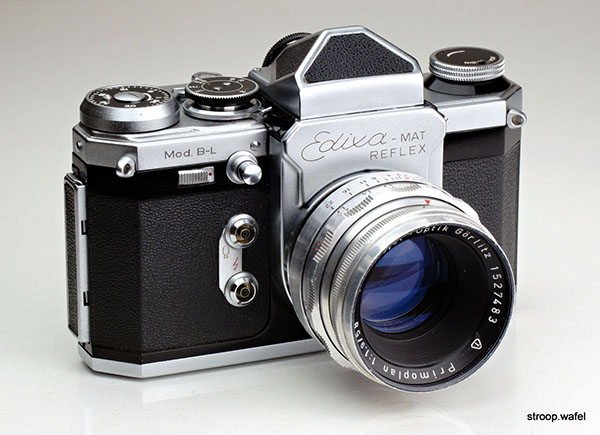
|
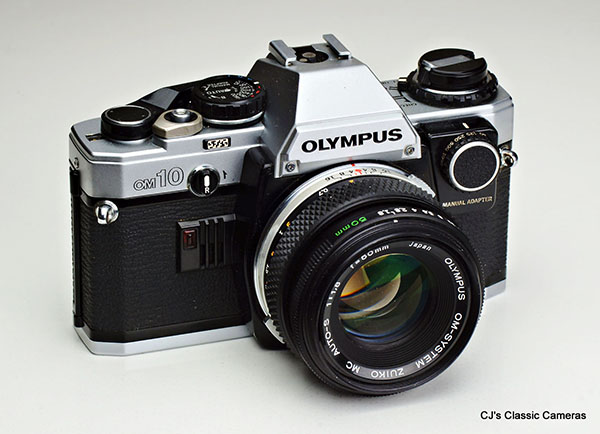
|
|
Wirgin Edixa-Mat Reflex
|
Olympus OM10 / OM2
|
|

